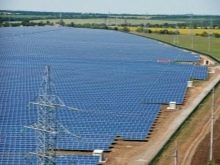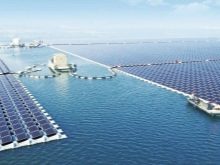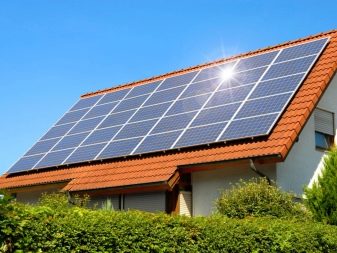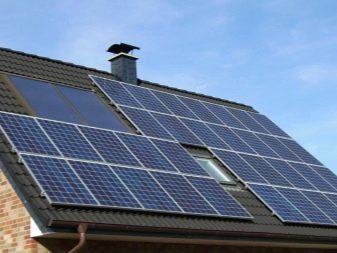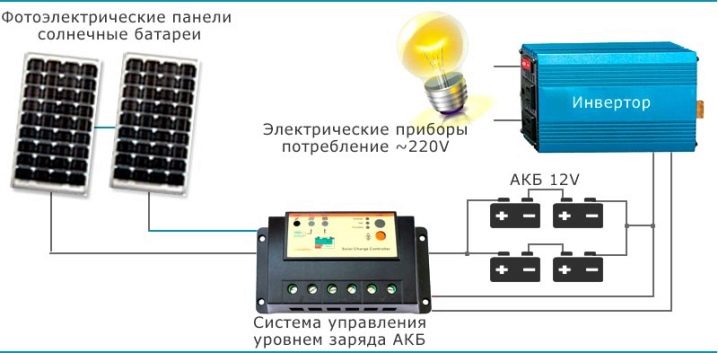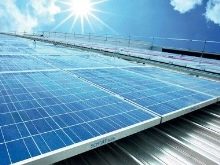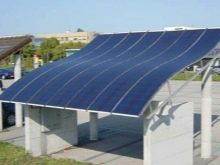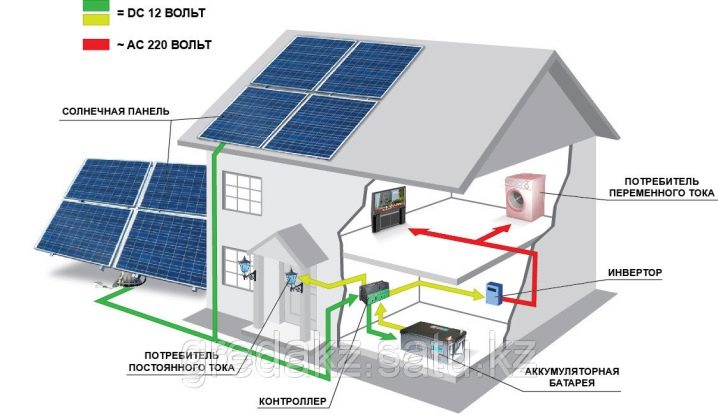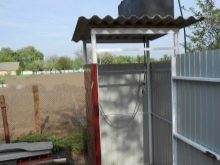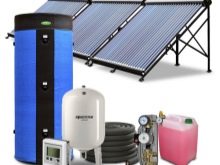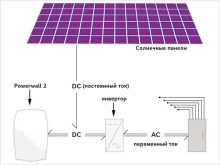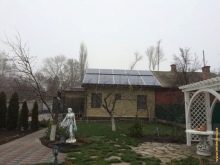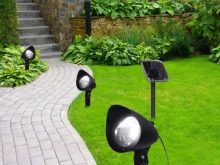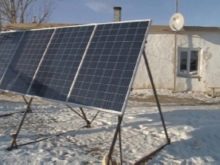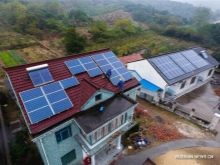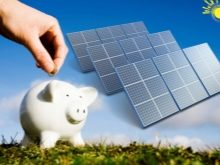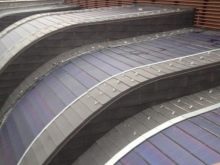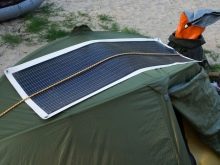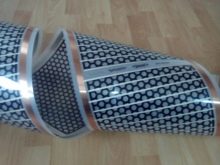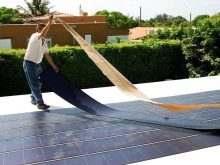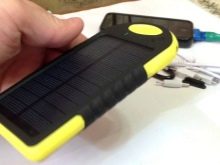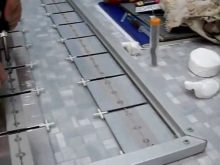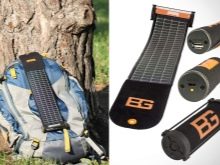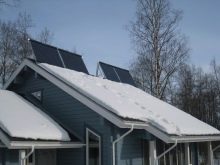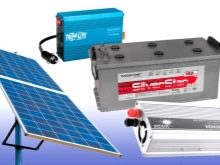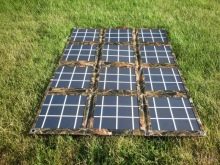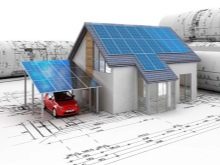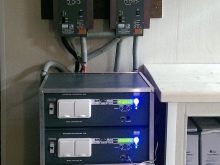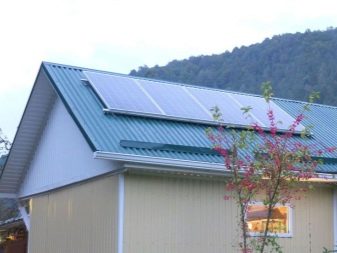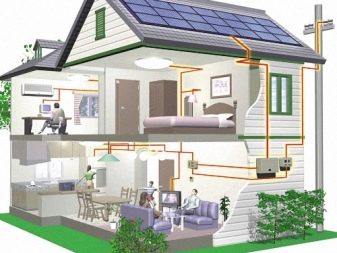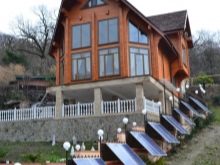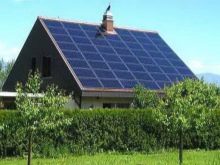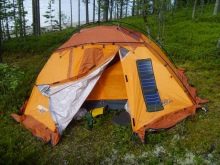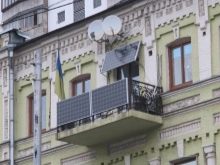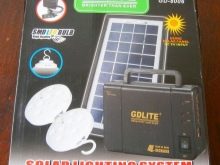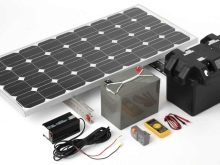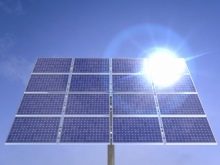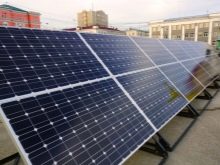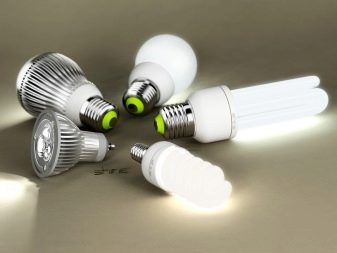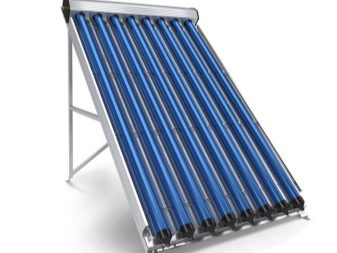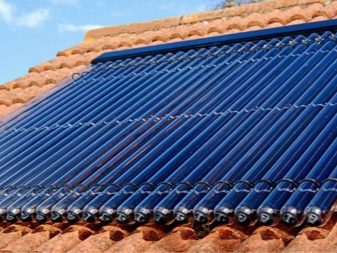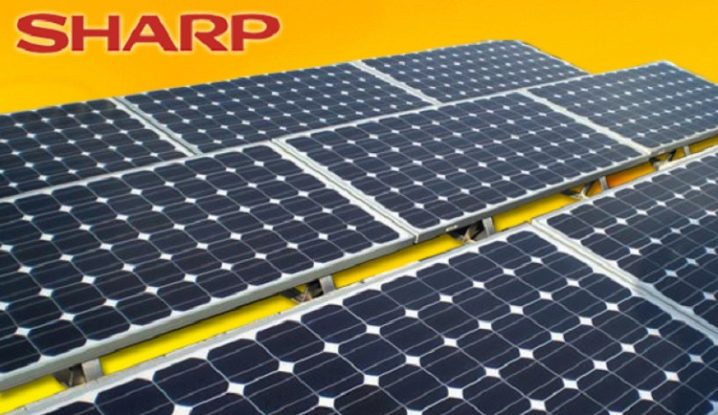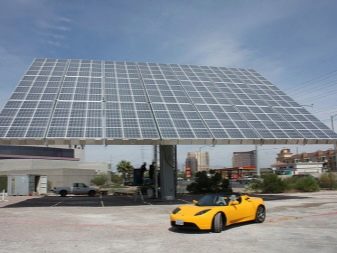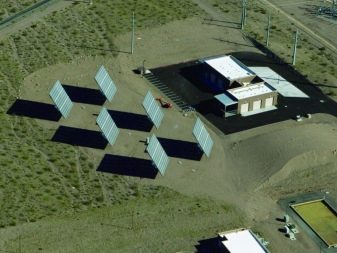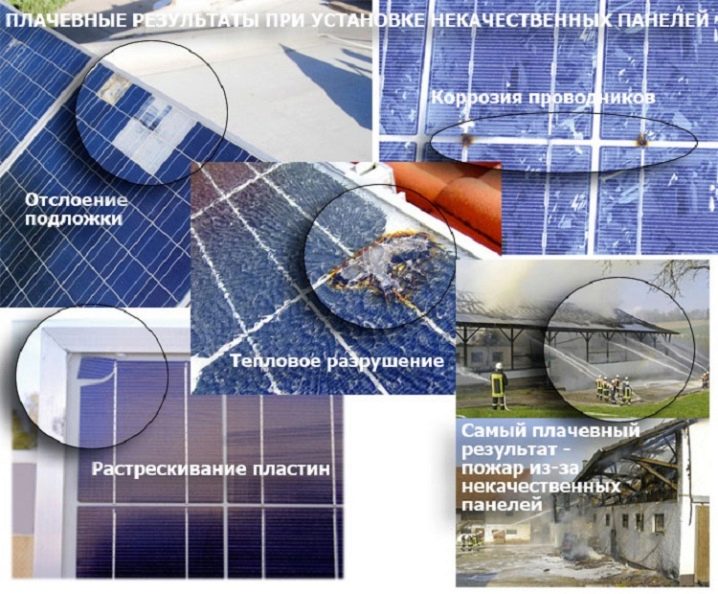Solar panels: characteristics and features of use
Every minute a lot of solar energy reaches the surface of our planet, without which life on Earth is impossible. However, this is not all that it is capable of; today we are entering the era of alternative renewable energy sources, using the activity of the Sun, wind and water. The largest solar power plants already produce about 1% of the world's electricity, so the future is in new developments. And we owe this to science and modern technologies, thanks to which this has become possible.
Device panels
Growing in the price of electricity willy-nilly makes you think about saving. And an excellent alternative in this case are natural sources of energy. The optimal solution for a private house is an alternative power plant - solar battery.
Initially, it may seem that the entire solar system is too big, and the principle of its operation is incredibly complicated. And in order to understand how a solar battery functions in business, it is necessary to consider in detail its design.
In fact, the heliosystem is quite simple and consists of four main elements.
- Solar battery - in shape and size is a rectangular panel with a certain number of plates. The basis of the solar cell includes semiconductor materials. Miniature transducers are assembled into modules, and the modules into a single solar collector system.
- Controller - performs the function of an intermediary between the solar module and the battery. It is necessary to monitor the battery charge level. Its role is extremely important in the whole circuit - the controller does not allow the electric potential to boil or fall, which is necessary for the stable functioning of the entire system.
- Inverter - converts the direct current of the solar module in the AC 220-230 volts. The hybrid mains inverter can use both direct and alternating current for its operation.But it should be borne in mind that the inverter also requires energy, and its consumption is about 30% of the conversion losses. And in cloudy weather or at night, all the energy for the work will be consumed from the battery. That is, if the battery is discharged, the inverter will stop working.
- Battery - converted into electricity, solar energy is not always used in the house in full. Surplus may accumulate in the battery and be used in the dark and cloudy weather.
But before proceeding to the selection and installation of a solar battery on the roof, it is necessary to understand the principles of operation of the device, as well as to calculate the working nodes of the solar system.
Specifications
The main element of each solar cell is a photoelectric converter.
In mass production, three types of silicon elements are used.
- Monocrystalline - artificially grown silicon crystals are cut into thin plates. The module is based on purified pure silicon. The surface is more like a honeycomb or small cells that are interconnected in a single structure.Finished small plates are interconnected by a grid of electrical wires. In this case, the production process is more labor-intensive and energy-consuming, which affects the final cost of the solar battery. But monocrystalline elements have higher productivity, and the average efficiency is about 24%. The service life of single-crystal batteries is longer, they will last an average of about 30 years.
- Polycrystalline - based on silicon melt. Such modules are considered the best solution for residential private country house. Several silicon crystals are combined into one photocell. The surface of a polycrystalline solar cell has a non-uniform surface, because of which it absorbs light worse. And the efficiency, respectively, below, is within 20%. The service life of the polycrystalline panel is 20-25 years. They have a characteristic difference - dark blue color of the coating. Such modules are cheaper than analogs, which allows you to recoup the entire system in about 3 years.
- Thin film - have a flexible substrate that allows you to mount the battery on any surface with corners and bends. A thin layer of semiconductors is sprayed onto the surface.batteries. Such systems have an obvious drawback - small efficiency. Productivity on average is about 10%. That is, to provide energy at home, it will take twice the amount of thin-film batteries as polycrystalline ones. And the service life of such panels is less than other analogues - on average, the service life is about 20 years.
Ideal if the solar panels can fully provide the house with electricity. But quite often the energy of the Sun is used for hot water supply or for heating. But in order to accomplish any of these goals, it is necessary to calculate the actual power per square meter and the required number of modules. The power of the solar module depends on the amount of sunlight that falls on the surface of the battery. To make the right choice, you should also study the principle of operation of a home mini-power station.
Operating principle
The first prototype of the solar collector, which has been known to everyone since the last century, is a summer summer shower. It was a large container, which was painted black, the water in it was heated during the day, which allowed every summer resident to take a warm shower in the evening.
The solar collector is a flat panel located on the street.usually on the roof, and is able to convert 90% of solar radiation into energy. In the future, the energy is sent to the system and distributed to the needs of power supply. But if the solar system is used for heating or hot water, then the energy with the help of a low-power pump is sent to the storage tank.
At different times of the day and in different seasons the level of illumination changes. Therefore, to ensure uninterrupted energy supply to the house, the solar battery has a whole system. Scientists have learned to control such a microphysical phenomenon as the photoelectric effect. And although, at first glance, the principle of operation seems to be technically complex, in reality, the principle of operation and the circuit of the electric circuit look very simple.
The main task of the entire system is to convert the energy of the sun and produce a direct current of a certain size.
Advantages and disadvantages
Anyone can install solar panels in their home.
In addition, they have many advantages.
- Energy efficiency - depending on the type of solar cells have a different indicator.But the average efficiency is from 14 to 30%.
- Solar panels are especially in demand in the suburban areas. And there are two reasonable explanations for this. Firstly, the dacha plots are often located far from centralized sources of energy supply in areas with poorly developed infrastructure. And secondly, the conversion of sunlight into energy is especially important at the height of the summer season - in the summer.
- If necessary, the mini-power plant can be supplemented with new solar panels to increase power.
- Savings - for the southern regions of the country, the use of solar panels for hot water can save up to 60% of energy on average per year: 30% in winter and 100% in summer.
- Such systems are relevant not only for private use, for example, for the home, but also for businesses, educational and medical institutions. In the production workshop, the solar panel can be used as an additional source of heat for central heating in winter and in summer for supplying process hot water.
- The benefit is that you only need to pay for the equipment once, afterwards the system does not require any investments and maintenance.
- The ecological source of energy is a particularly important aspect in the planetary plan, because the energy reserves on Earth are not unlimited.
- Reliability - in this case, much depends on the chosen model and the correct installation.
Despite the many advantages, solar batteries have one weighty drawback: it is wiser to use them in regions with a small number of cloudy days a year, and there are a very limited number of such in Russia.
It is worth noting that the system pays off in a few years and allows the owner to save a lot of money in the future. For example, based on today's tariffs for electricity and diesel, we can say with confidence that the solar system will pay off in 3-4 years in a private country cottage for a family of 5-7 people. And when moving from gas - the payback will be up to 8-10 years.
Kinds
Today, various types of solar panels are gaining increasing popularity. At first glance, it may seem that all solar modules are the same: a large number of individual small photocells are interconnected and covered with a transparent film. But, in reality, all modules differ in power, design and size.And at the moment, manufacturers have divided the solar system into two main types: silicon and film.
For domestic purposes, solar panels are installed with silicon photovoltaic cells. They are the most popular on the market. Of which you can also distinguish three types - it is polycrystalline, monocrystalline, they have already been described in more detail in the article, and amorphous, which will be discussed in more detail.
Amorphous - are also made on the basis of silicon, but, in addition, also have a flexible elastic structure. But they are not made from silicon crystals, but from silane - another name is silicon hydrogen. Among the features of amorphous modules, excellent performance can be noted even in case of cloudy weather and the ability to repeat any surface. But the efficiency is much lower - only 5%.
The second type of solar panels - film, is produced on the basis of several substances.
- Cadmium - such panels were developed in the 70s of the last century and used in space. But today cadmium is also used in the production of industrial and domestic solar power plants.
- Modules based on semiconductor CIGS - developed from copper, indium selenide and are film panels. Indium is also widely used in the manufacture of LCD monitors.
- Polymer - also used in the manufacture of solar film modules. The thickness of one panel is about 100 nm, but the efficiency remains at 5%. But from the advantages it can be noted that such systems have an affordable price and do not emit harmful substances into the atmosphere.
But also today less bulky portable models are on the market. They are specially designed for use during outdoor activities. Often such solar batteries are used to recharge portable devices: small gadgets, mobile phones, cameras and camcorders.
Portable modules are divided into four types.
- Low-power - give a minimum charge, which is enough to recharge a mobile phone.
- Flexible - can roll up in a roll and have a small weight, thanks to this, due to the great popularity among tourists and travelers.
- Attached to the substrate - have a significantly greater weight, about 7-10 kg and, accordingly, give more energy.Such modules are specially designed for use in long-distance car travel, and can also be used for partial autonomous power supply of a country house.
- Universal - indispensable in hiking, the device has several adapters for simultaneous charging of various devices, the weight can reach 1.5 kg.
Winter performance
Frost weather does not matter for the solar system. The main thing here is the number of clear light days. And, for example, if you use a solar panel for hot water supply, even during the winter period of thirty-degree frost you can stably have water in the tank at a temperature of 40 ° C - 50 ° C.
In regions with a sharply continental climate and harsh winter, it is impossible to abandon central heating. But it is possible to supplement the system with indirect heating tanks, which allow combining various heat sources with the possibility of turning on the sun’s energy automatically and as needed.
And it is also possible to use a solar system to support heating in the “warm floor” system. At the same time for 100 square meters of floor you need about 8 collectors.But in the summer, such a large system will be redundant, except that you can use it to maintain the temperature in the pool or sauna.
In winter, it is wiser to use the energy accumulated over the summer. In this case, it will be necessary to additionally install a battery for the accumulation of electric charge.
Its role in the system is quite understandable - the battery will allow you to stock up on electricity from the solar module. And then it will be possible to use solar energy as electricity.
How to choose?
Installing a solar system on its own site will cost a decent amount. Before you start installing a solar battery, you need to determine the required power for all devices. And first of all, it is necessary to calculate the optimal peak load in kilowatts and rationally conditional average energy consumption in kilowatt / hour to meet the needs of the house or site.
For the rational use of solar electricity it is necessary to determine:
- peak load - to determine it, it is necessary to add the power of all devices connected at the same time;
- maximum power consumption - the parameter necessary to determine the category of devices that must work at one time;
- daily consumption is determined by multiplying the individual power of a single device by the time during which it was working;
- average daily consumption - is determined by adding the energy consumption of all electrical appliances for one day.
All these data are necessary for a complete set and stable subsequent work of the solar battery. The information obtained will allow you to choose more suitable parameters of the battery pack - an expensive element of the solar system.
For all the calculations, you will need a sheet in a cell or, if you prefer to work on a computer, then it will be most convenient to use an Excel file. Prepare a table template with 29 columns.
Specify the names of the graph in order.
- The name of the appliance, household appliances or tools - experts recommend starting to describe energy consumers from the hallway, and then move around clockwise or counterclockwise. If the house has more than one floor, then the starting point of all subsequent levels is the staircase.And also indicate the street electrical appliances.
- Individual power consumption.
- Time of day from 00 to 23 hours, that is, for this you need 24 columns. In the columns over time, you will need to specify two numbers in the form of a fraction: the duration of work during a specific hour / individual power consumption.
- In column 27, indicate the total operating time of the appliance per day.
- For 28 columns, it is necessary to multiply among themselves the data from 27 columns by individually consumed power.
- After filling in the table, the total load of each device is calculated for each hour - the obtained data is entered into column 29.
After filling the last column is determined by the daily average consumption. For this, all the data in the last column are summarized. But this calculation does not take into account the consumption of the entire solar collector system. To calculate this data, it is necessary to take into account the auxiliary factor in the final calculations.
Such a careful and painstaking calculation will provide a detailed specification of energy consumers, taking into account hourly loads. Since solar energy is very expensive, its consumption must be minimized and rationally used to power all devices.For example, if the solar collector is used as a backup power supply at home, the data obtained will eliminate energy-intensive devices from the network before the final restoration of the main power supply.
For a constant supply of energy to the house from the solar battery when calculating the hourly loads are pushed forward. Electricity consumption must be adjusted in such a way as to exclude emergency situations during system operation and to level the maximum loads.
In this case, all the maximum loads should coincide with the maximum activity of the sun, that is, fall on the daytime.
This graph clearly shows how to efficiently use the energy of the sun in the house. The initial graph shows that the load was distributed randomly during the day: the average daily hourly rate was 750 W, and the consumption indicator was 18 kW per hour. After accurate calculations and proper planning, it was possible to reduce the daily consumption rate to 12 kW / hour, and the average daily hourly load to 500 watts. This power distribution option is also suitable for backup power.
Scope of application
Solar panels are the most outstanding achievement in the field of alternative energy. They perform an essential function for energy saving and preservation of the benefits of civilization. In the summer, in the country, solar panels can be used to provide power for electrical appliances and household appliances, heating systems, or for hot water.
Tourists and travelers, as a rule, choose portable solar batteries for charging portable devices. They are irreplaceable in places where there is no power supply.
Such devices can also be used to power the apartment. And if the windows of your apartment overlook the sunny side, you can safely install solar panels on the balcony or front of the house, you only need to first obtain permission from the management company or the HOA.
Wiring diagram
Solar panels can be placed on the roof of the house, whether it is sloped or flat, or on the balcony, facade, or even in the courtyard. But it will also be necessary to allocate space in the attic or in the basement for the rest of the system.
You must follow the basic recommendations of experts when installing a solar panel.
- Carefully consider all elements of the solar system before buying for damage and defects. During shipment, keep the original packaging of the kit to prevent damage to the integrity of the screen.
- The main elements of control and adjustment of solar cells occupy a minimum of space. As a rule, the necessary minimum includes an inverter, controller and battery. Also, if the climate of the region and the technical features of the site allows, the control and monitoring devices can be installed on the street. But it is better to choose a heated dry room for the entire system of a mini-power plant, because when the ambient air temperature drops to -5? C, the battery capacity is halved.
- Solar modules, controllers and inverters are available under 12, 24 and 48 volts. Large voltage allows the use of wires with a smaller cross section. But the lower the voltage, for example, at 12 V, it is easier to replace broken batteries. When working with 24 volts, you will need to replace the batteries in pairs. And when replacing a 48 volt battery, you will need 4 batteries on one branch, which, in turn, is dangerous and can lead to electric shock.
- For a solar battery system, you must use special batteries labeled Solar. Ideally, all batteries should be from the same manufacturer and from the same batch.
- The number of photocells in one module should be from 36 to 72 pieces - this is the optimal amount for obtaining the stated current. You should not install dual modules with the number of photocells from 72 to 144. First, they are problematic to transport. And secondly, they are the first to fail in severe frosts.
- Large modules should have a reinforced case and additional protection in the form of glass. Since the modules are installed on the roof, they are heavy loads in the form of precipitation and wind.
- It is necessary to assemble a solar battery kit in an open area or in a spacious room.
- To install a solar panel on a plot, it is necessary to choose a well-lit open space on which no shadow appears from adjacent buildings or trees. Perfect for this fit the roof of the house or any other building.
- The angle of inclination of the solar modules plays a big role in obtaining energy. The flow of energy is proportional to the position of the sun.Therefore, it is worthwhile to foresee the possibility of changing the angle of inclination for fastening when the season changes, when the position of the sun and the direction of the rays change.
Homemade
Integrated heliosystem will require considerable investment. But all the money spent will be returned in the future. The payback period depending on the number of modules and methods of using solar energy will vary. But it is still possible to reduce initial costs not at the expense of quality loss, but at the expense of a reasonable approach to the choice of solar battery components.
If you are unlimited in the installation area of the solar modules, and you have decent space, then 100 square meters. You can install polycrystalline solar panels. This will save a considerable amount in the family budget.
Do not try to completely cover the roof with solar panels. To begin, install a pair of modules and connect to them the equipment that operates from constant voltage. It is possible to increase the power and increase the number of modules over time.
If you are limited in budget, you can refuse to install the controller - This is an auxiliary element that is needed to track the battery level. Instead, you can additionally connect another battery to the system - this will avoid overcharging and increase system capacity. And to control the charge, you can use regular car clocks, which can measure voltage, and they cost much less.
And one important tip, replace all incandescent bulbs with modern ones. Ideally, use LED - they have much lower power consumption and they work from 12 V.
Popular manufacturers and reviews
When choosing a solar battery for the home, you should focus not only on the price-quality ratio, but also on the brand. You must absolutely trust the manufacturer in this important matter. And in order to make sure of the quality of products, you should get acquainted with the technical passport and reviews.
Often in the market you can find a tubular vacuum solar collector. Such panels are made mainly in China and theoretically have a higher efficiency. But in winter, frost forms on such items and snow sticks to the surface.The layer of precipitation does not let the sun's rays through, and on a hot summer day such a system can “boil” if it is not covered in time to protect it from overheating.
Consider the most popular solar cells on the market.
Sharp
Sharp is a brand of a Japanese corporation, widely known in the production of high-power solar cells. Manufactured products are subject to thorough research and testing. Solar modules have three layers, and the efficiency ranges from 37.9% to 44.4%.
Ies
IES - produced in Spain. The main feature of the product is considered two layers of the module and efficiency within 32%, which ultimately is reflected in the cost. Spanish brand solar panels are much cheaper than Japanese counterparts, but still remain very expensive to use in private homes.
Amonix
Amonix is also among the leaders in the production of solar cells for industrial use. The effectiveness of products is 36%.
Sun power
Sun Power - American brand solar panels are also included in the rating of effective systems. The efficiency of popular models is 21%.
Telecom-STV
Telecom-STV - Russian-made panels (Zelenograd) also occupy a leading position among manufacturers. The range of products is very wide. The company offers single-crystal batteries from 18 to 270 W, multi-crystal - from 5 to 250 W, for marine use - from 16 to 215 W, and folding - from 120 to 180 W. The efficiency of solar modules is 20-21%, but at the same time the cost of batteries is lower by 30% compared to imported brands.
This is only a small part of the well-known manufacturers of solar cells. But do not discount other domestic brands. So, for example, the company Hevel (Chuvashia, Russia) produces micromorphic thin-film batteries. And as research has shown, the company's improved panel more effectively captures the rays of scattered energy. And, not least, the solar batteries of the domestic manufacturer have an attractive appearance and can be installed not only on the roof, but also on the facade of the building.
Do not consider to install cheap dual solar modules with a large number of photocells. As practice shows, during the anomalous frosts that systematically hit many regions of the country, it is these panels that first break down.The thing is that a thin transparent film stretched on the surface of the module is compressed in the cold and peels off from the large tension and breaks. Why the performance of the solar battery falls, which can lead to a quick failure.
When choosing a suitable system, it is also necessary to pay attention to the fact that the power of the solar system decreases with time by 10%.
Also reduce the resource panels can:
- damaged film on the surface of the module;
- film clouding;
- surface deformation.
Not so long ago, scientists came to the conclusion and proved the possibility of storing heat in the soil. What opens up great prospects for alternative energy. Excess summer heat can be stored underground in ground or water heat accumulators located at a depth of 2 to 35 meters, and use energy in the winter as heating or electricity.
Tips for solar panels - in the next video.


